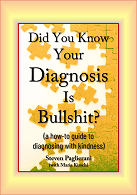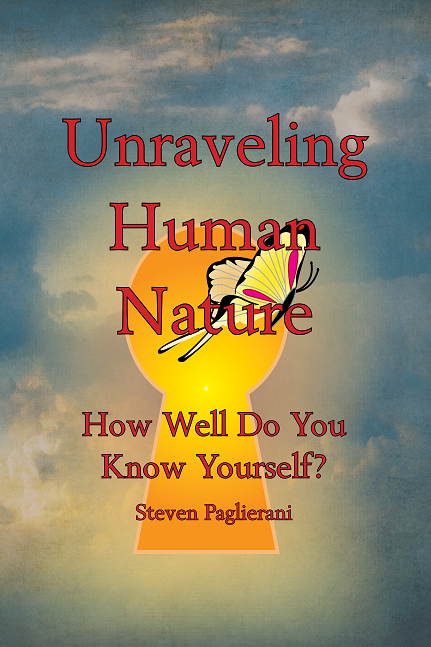
Do You Know Yourself?
Have you ever taken a personality test? Has doing this ever changed your life?
In this book, you'll learn how to use a series of simple personality tests to permanently change your life. These tests enable you to describe with just five words the part of you which is measurably unique. Indeed, of the six billion people on the planet, there are only 120 just like you. Thus once you know these five words, you'll have the power to predict much of what you'll think, feel, say, and do.
You'll also learn where this power comes from—from a personality theory the likes of which the world has never seen. For one thing, it's fractal. Thus like the fabled onion of personality and the Russian nesting dolls, everything in it connects to and resembles everything else. For another, it uses everyday language. So you won't need to spend years painfully ingesting—and trying to understand—mountains of psychobabble and statistical fecal matter.
Best of all though, in it, no one is blamed or broken or evil or worthless. We're all just human, each doing our best to find our own truth.
PSY023000 PSYCHOLOGY / Personality
PSY042000 PSYCHOLOGY / Assessment, Testing & Measurement
SCI075000 SCIENCE / Philosophy & Social Aspects
Discovering The Mind's Design (by reverse engineering technology)
In the 19th century, scientists had a belief that things in the physical world; physical patterns, and things in the mind; mental patterns, mirrored each other: that the same patterns were at work. And when I first explored this, I assumed they were saying that we can use the patterns in physics as metaphors for the mind. But after years of exploring human nature and using what I found in my therapy room, I started to realize there was much more to it.
In this video, I talk about that how this led me to a rather unusual discovery. I realized reverse engineering our technology reveals the patterns inherent in personality itself. I then used my knowledge of computer operating systems to create a ten layered personality theory, the first to be based entirely on a single fractal pattern.
Transcript of the Video
One of the more interesting things that I find about living in this time in the world is the way that technology changes our ability to know human nature. What I mean by that is that, for some years now, I've been a personality theorist—a strange phrase. It means, I am a man who studies human nature and writes about it, and in particular, looks for the kind of patterns that the physicists of the 19th century looked for in the physical world.
I remember reading that Freud had been inspired by those same patterns, and that he had wanted to find the same patterns in human nature. And this affected me a lot, in particular, the idea that there are certain patterns in the world that are universal. This idea changed my attempts to know people and made my search a very complicated process.
How?
The Ninteenth Century Idea of Psychophysics
One of the things that they had in the 19th century—especially in the mid-19th century—was a belief that things in the physical world—physical patterns, and the things in the mind—mental patterns—mirrored each other, in effect, that the same patterns were at work. And when I first explored this, it seemed as if all they were saying was that we can use the patterns in the world of physics and so on as ways of speaking about the mind. However, after some years of exploring human nature, and writing about it and honestly, taking what I found and then using it in my therapy room, I began to acquire enough of these patterns to be able to use them to help people. And the more I found I could help people with these patterns, the more I felt drawn to know them.
At some point, I realized that there must be a way to begin to put these patterns together—that people are holistic and their patterns are not separate. As in the real world, you are not going to take a living frog and cut it in pieces, study the pieces, learn something, and then be able to put that frog back together. You can't do it with human beings—including with their minds—either. The only way to really know a human being—or a frog; a living frog—is to know them alive, living, in the world.
Do Computers Mirror the Mind?
One day, I found myself wondering how computers are related to the mind. I had read an article that said that it was naive to use a computer as a model for the mind—that the human mind was much different, and that the computer was more or less just a machine which remembered things very mechanically and had no ability to draw meaning from things, and so on.
As I began to think about this, I recalled some of the things I had learned in school. Most people don't know I have a bachelor's degree in microcomputers—a four year degree in studying the nature of computers, and how to build them, and so on.
In this case though, I'm talking about computer operating systems. This phrase is just a fancy way to refer to the computer's personality. In fact, currently, there are several personalities that people can buy in computers. There's the Apple personality, which originally was quite visual and graphic and so on. And the PC personality, which was originally more text-based and thus came to look a lot similar to the Apple. And the Linux personality, which remains a lot like versions of the PC.
The point is, all three of these operating systems are reflections of the personalities of the designers of each computer. And different human personalities are drawn to the different kinds of computers, in part, because of the operating systems. They are the personality of each computer. They affect the way it interacts with you, and with your nature.
I thought about this. I thought about it a lot. I have not even, to this day, seen people talk about computer operating systems as being analogous to human personalities. But they very much are. And one particular aspect of computer operating systems is something that kept drawing my attention. And this idea—an idea most people would not know unless you had studied computer operating systems—is that the computer operating system is constructed like an onion—in layers.
Computer Operating Systems Are Layered
And so, imagine it's an onion with six layers. And in the center of this onion, in the innermost layer, is the kernel. This happens to be what it's called in computer operating systems as well. And this is the basic living part of the personality.
Then there is a layer outside of that which perhaps is the layer that interfaces the computer's heart and soul with the machinery—the hardware that contains it. And so here's a second layer surrounding the first. And it acts as a bridge. So perhaps there's a third layer around that second layer. And that's for the hardware to talk to the outside world, like to the internet and so on, and to other computers and so on.
The point is, each computer operating system has a series of these layers—a kernel and then a layer, and then a layer, and a layer and a layer. And this enables the computer personality—the kernel—to talk with the various pieces, like the keyboard and monitor and so on, for that computer, but also with other computers.
Can Human Personality Be Layered As Well?
To tell you the truth, I cannot remember the moment where I realized that human personalities were constructed the same way. I've never read that. It isn't a way that people generally describe human nature, although we've used the idea of an onion and peeling an onion and so on to get to know people. But no personality theorist has yet said it's literally true, it's not just a metaphor. And I cannot remember when I began to try and think it through as to what was in the layers.
But I can remember a day, and I was sitting with a client in my therapy office. And the woman was perhaps in her early 40's and a very intelligent woman, and a chiropractor, and very knowledgeable about nutrition and many other things.
And I remember drawing for her the 10 layers of personality that would be very soon become my personality theory. I can still picture showing her each of the layers. And in the drawing, I'm not even sure originally how I thought of this, but the kernel, the very center of the onion, is layer 10.
And I came to talk about it as the 10 represents the level of intensity in the personality, how much energy this particular layer holds. So there's layer 10. And there are 10 layers, so 10, 9, 8, 7, 6, 5, 4, 3 2, 1. And each one describes roughly the intensity.
Well, I remember drawing this for her on the back of a paper place mat that I had gotten from a Chinese restaurant. And I think I got Chinese food that day. I still ate that kind of thing then. And I remember her reaction. And her reaction was, where do you come up with these things.
Can We Also Have a Kernal—a Core Personality?
It's interesting how a small comment can give you encouragement or a clue that you're on the right track or that there's something there that's more than ordinary. OK, so story aside, I went on to write an entire theory of personality, including using the methods from the scientific method, the constellated science, to developed tests to test for what I came to call the core personality.
There are five parts to this core personality. Four of them are the four parts of layer 7. And one is the speed at which the person interfaces with the outside world. It's roughly fast or slow.
But all of that aside, everything that I have just talked about comes back to the idea that I began with, which is that I was looking for patterns that were universal in human nature, that all people had some variation, a measurable variation, of each of these patterns.
There are four patterns in layer 7, one inside the other. Layer 7 is actually a little miniature layer onion. And there's four—a layer, and then a layer, and a layer, and a layer. There are four layers.
Can Reverse Engineering Technology Reveal Human Personality?
But the point is, this entire idea about personality resembling a layered operating system came from a very simple question. If human beings designed technology, wouldn't this technology be made in the likeness and image of the minds of human designers?
In other words, imagine aliens from far away, light years away, with a sun that is a different color. Their vision would be in a different range. Perhaps they would see in the infrared range or in ultraviolet or in something else different than we do.
They have sight. This pattern is universal. But it's a different variation. So if they made things and if they made art, this art would naturally be made in the ranges of color they could see. Their art would be made in their likeness and image.
The same would apply to their technology, their screens, the things they would read on and so on. All of it—their books, their teaching methods—everything would be made in their likeness and image.
This hold true for us as well. We make our technology in our likeness and image. And during my lifetime, it's been absolutely incredible how this has advanced. There were no televisions when I was born. And now we have televisions thousands of times greater in the phones that we carry around in our pockets. It's hard to imagine.
Technology is Made in our Likeness and Image
The main point is, again, I realized that if I wanted to understand the human mind—and the mind is invisible, it's invisible, it's a mind—that I could absolutely see the patterns of the mind if I look at the technology that this mind had created.
It's a fascinating idea to me because, for instance, the camera that is recording this now has an awful lot of the same problems that our eyes have. The camera is not up to our eyes yet. We're closing in on that. But the eyes are just incredible when it comes to the ability to see ranges—from light to dark contrast.
But the point being that in learning about the camera technology, I turned to learning about the eye. And in learning about the eye, I learned more about how cameras work. In between that, I realized that in my office—in particular, the room in my office where I do therapy—that I intuitively used colors in that room that felt right to me, mostly sage greens and some yellows and very little violets and reds.
But the point is that as I was studying the eye, I was surprised to find that the amount of color, the sensitivity in the eye is not even. It's not a flat line. The eye isn't as sensitive in the reds as it is in the greens or the yellows and so on. And it turned out that the amount of area that had colors on it exactly matched the amount of sensitivity in the human eye. Most of my room is that color green that the eye is most sensitive to.
We mirror our technology. Our technology mirrors us. Even the idea of decorating a room mirrors our personality. In this way, we have a window into our minds and our souls from the machines that we make. This is not about worrying whether the machines will take over our world.
I don't know whether they will or they won't. But if they do, it will be because we designed them in our likeness and image and they'll have our flaws. And how sad would that be.
But that's for another day. And hopefully, this has made some sense, this rambling, the idea that if you want to know the mind and human personality, look at the technology we create and learn how it operates, learn its limitations, learn what it does and doesn't do because it will reveal that invisible part of us, our mind.
Books by Steven Paglierani
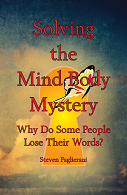
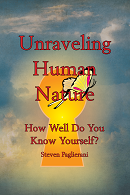
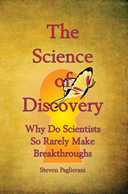
.png)
